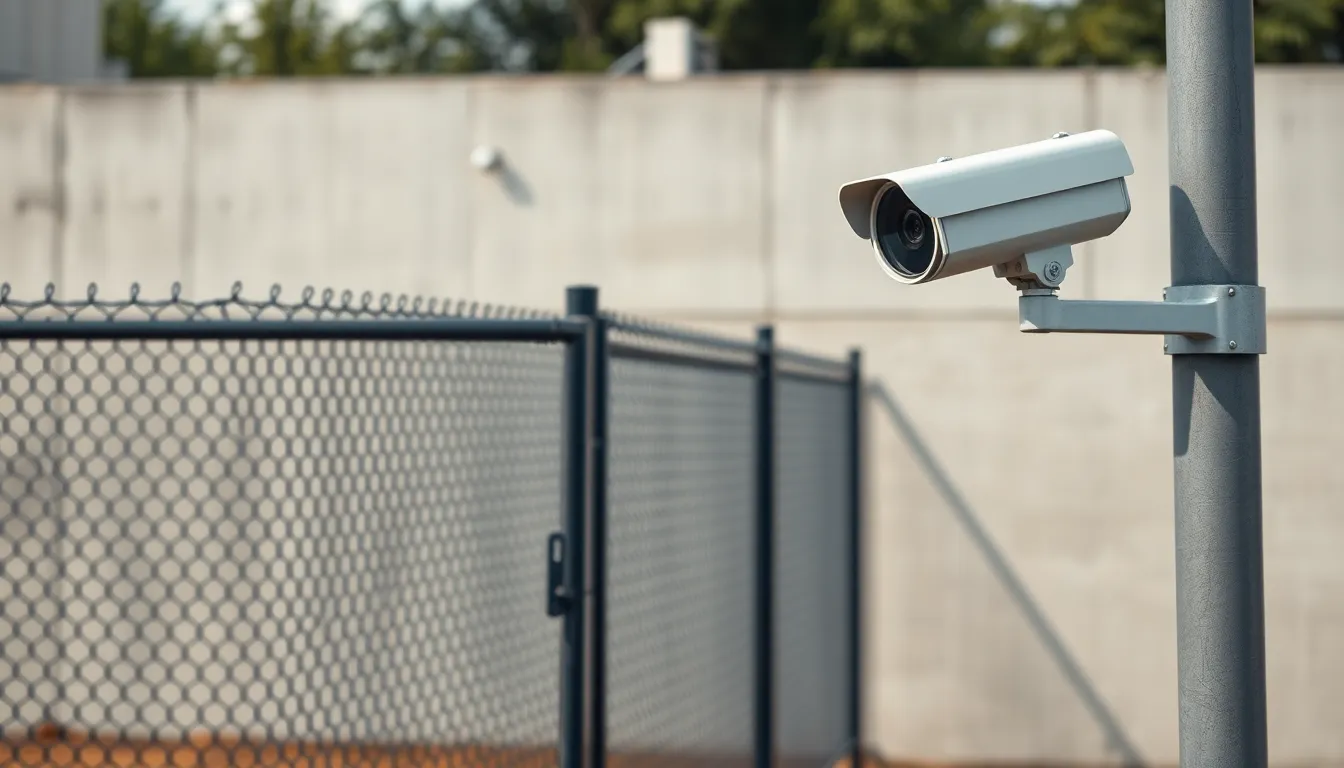Table of Contents
ToggleIn a world where intruders seem to have more tricks up their sleeves than a magician at a kids’ party, perimeter security has never been more crucial. It’s not just about keeping the bad guys out; it’s about giving peace of mind to those inside. Imagine a fortress that not only looks imposing but also works harder than a caffeinated squirrel on a mission.
Overview of Perimeter Security
Perimeter security focuses on safeguarding the outer boundaries of a property. This approach involves physical deterrents, surveillance technologies, and access control measures, creating a formidable defense against potential threats. Effective systems include fences, walls, and gates, designed to deter intruders and restrict unauthorized access.
CCTV cameras and motion detectors serve as critical components, allowing for real-time monitoring and alerting security personnel of suspicious activities. Additionally, security personnel patrolling the perimeter enhances immediate response capabilities. The integration of these technologies helps maintain a secure environment for occupants.
Intrusion detection systems play a vital role in perimeter security. By utilizing sensors along the property line, these systems can detect breaches swiftly. Advanced video analytics can also analyze footage, identifying potential threats before they escalate.
Access control measures, such as keycard systems or biometric scanners, limit entry points to authorized personnel only. Incorporating these technologies significantly reduces the risk of unauthorized access while facilitating smooth and controlled entry for legitimate users.
Recent statistics illustrate the effectiveness of perimeter security. According to security industry reports, improving perimeter security can decrease unauthorized access incidents by up to 40%. This reduction not only enhances safety but also fosters confidence among employees and residents within secured areas.
Ultimately, a comprehensive perimeter security plan combines technology, physical barriers, and trained personnel. Each component plays an essential role in creating a protective environment, minimizing risks, and ensuring peace of mind for those within the secured perimeter.
Types of Perimeter Security Systems

Various perimeter security systems enhance protection by utilizing multiple strategies and technologies. Different categories exist, including physical barriers and electronic security solutions.
Physical Barriers
Physical barriers serve as the first line of defense in perimeter security. Fences made of various materials, such as chain-link, wood, or steel, deter unauthorized access while clearly marking property boundaries. Walls, including concrete and brick options, provide additional height and sturdiness, acting as visual deterrents for potential intruders. Gates, both manual and automated, regulate entry points while allowing easy access for authorized personnel. Access control gates equipped with locks enhance security by requiring credentials for entry. Recent statistics report that homes and businesses with robust physical barriers experience a reduction in break-ins by approximately 30%.
Electronic Security Solutions
Electronic security solutions monitor and protect perimeter areas effectively. CCTV cameras capture real-time footage, serving as a deterrent while preserving evidence in case of incidents. Motion detectors swiftly identify movement, triggering alerts to security teams or alarms. Intrusion detection systems, featuring sensors along property lines, instantly notify security personnel of breaches, allowing for rapid response. Video analytics software improves threat detection by assessing behaviors and flagging suspicious activities. Access control systems, including keycard readers and biometric scanners, limit entry to authorized individuals, significantly diminishing the risk of unauthorized access. Utilizing these electronic solutions enhances overall security protocols, fostering a safer environment for all.
Benefits of Effective Perimeter Security
Effective perimeter security offers numerous advantages for properties. Enhanced safety serves as the primary benefit, significantly reducing the risk of unauthorized access. Properties with robust perimeter security experience a roughly 40% decrease in unauthorized entry incidents. Employees and residents alike gain peace of mind, knowing that comprehensive measures protect them.
Cost savings also stem from efficient perimeter security measures. By preventing break-ins, businesses can avoid expenses related to theft and vandalism. Statistics reveal that effective physical barriers contribute to a 30% decrease in break-in occurrences. These savings allow resources to be allocated to other important areas instead of constant repairs or losses.
Increased property value often results from strong perimeter security systems. Prospective buyers view secure properties as attractive investments, leading to higher market value. Effective security measures reassure stakeholders, whether they are employees, clients, or residents.
Rapid response capabilities form another benefit of a well-designed perimeter security system. Surveillance technologies and trained personnel ensure swift action during incidents. Monitoring systems equipped with advanced technology can detect threats before they escalate.
Enhanced operational efficiency arises from integrated security systems. Centralizing security functions streamlines management and response processes. Coordinated systems, such as access control and surveillance, contribute to cohesive defense strategies while maximizing overall effectiveness.
Finally, regulatory compliance becomes more manageable with effective perimeter security. Organizations that adhere to safety standards demonstrate their commitment to protecting employees and assets. Compliance avoids potential legal issues and fosters a positive organizational reputation. Each of these benefits underscores the critical importance of prioritizing effective perimeter security measures.
Challenges in Implementing Perimeter Security
Numerous challenges arise when implementing effective perimeter security. High costs often deter organizations from investing in comprehensive systems. Security solutions including extensive fences and advanced surveillance technologies require significant financial resources.
Complexity sometimes complicates integration with existing infrastructure. Businesses may struggle to merge new electronic security systems with older physical barriers. Concerns also exist regarding the reliability of these technologies, as false alarms can result in decreased trust and responsiveness.
Inadequate training for personnel contributes to vulnerabilities. Without proper education, staff may struggle to respond effectively to security threats. Communication gaps can hinder rapid responses during critical incidents, undermining the purpose of the security system.
Regulatory compliance adds another layer of difficulty. Organizations must navigate complex legal requirements related to employee privacy and safety. Failure to adhere to these regulations could lead to legal repercussions and damage to reputation.
Overlapping responsibilities among contractors can create confusion. Clear delineation of duties is crucial to effective perimeter security management. Organizations sometimes face challenges ensuring that each party understands their role, which can lead to gaps in security measures.
Environmental factors may also impact the effectiveness of perimeter security. Weather conditions like heavy rain or snow can affect the performance of surveillance equipment and motion detectors. Moreover, evolving tactics used by intruders necessitate continuous updates and adaptations to existing security measures.
Addressing these challenges requires a strategic approach. Organizations must prioritize investments based on specific risk assessments and vulnerabilities. Continuous training and clear communication among personnel strengthen response capabilities. By recognizing these hurdles, businesses can enhance their perimeter security strategies effectively.
Future Trends in Perimeter Security
Innovative technologies will shape the future of perimeter security. Increased use of artificial intelligence enhances threat detection capabilities significantly. Organizations now integrate machine learning algorithms into surveillance systems to analyze patterns and predict potential breaches. Greater efficiency in response times will emerge from these advancements.
Evolution in perimeter fencing materials is noteworthy. Manufacturers create composite materials that combine lightweight features with solid durability. These innovations increase physical barriers’ effectiveness and aesthetic appeal, addressing both security and visual concerns.
Enhanced collaboration between electronic security and physical barriers is on the rise. Integration of video analytics with motion detectors allows for real-time alerts based on specific criteria. This synergy reduces false alarms and focuses resources on genuine threats.
Adoption of cloud-based security solutions is another trend driving change. Cloud infrastructure offers flexible access to security systems from remote locations. Organizations benefit from improved data management and sharing capabilities, making it easier to coordinate responses during incidents.
Emerging regulatory standards influence perimeter security strategies. Keeping pace with evolving regulations requires proactive measures, ensuring organizations maintain compliance while maximizing security effectiveness.
Aligning perimeter security with overall business continuity plans also becomes essential. Decision makers increasingly recognize that effective security is integral to operational resilience. Implementing comprehensive training programs ensures personnel are well-prepared for unforeseen events.
Sustainability considerations will gain importance in developing perimeter security measures. Organizations focus on eco-friendly materials and energy-efficient technologies to minimize their environmental impact. This trend reflects a growing awareness of corporate social responsibility within the security industry.
Maintaining awareness of these future trends empowers organizations to adapt and strengthen their perimeter security. Prioritizing investments based on evolving threats enhances overall safety and mitigates risks more effectively.
Perimeter security is essential in today’s landscape of evolving threats. By implementing robust physical barriers and advanced electronic solutions organizations can significantly enhance their safety and operational efficiency. The integration of innovative technologies not only improves threat detection but also streamlines response capabilities.
Investing in comprehensive perimeter security measures fosters a sense of security among employees and residents while protecting valuable assets. As organizations navigate challenges such as cost and technology integration it’s crucial to prioritize strategic investments based on thorough risk assessments.
By staying informed about emerging trends and adapting their security strategies organizations can ensure a resilient and secure environment for all.




